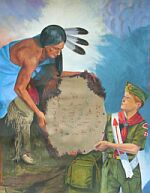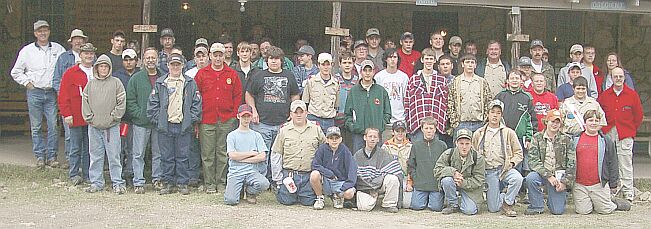 |
Otena Lodge HistoryOrder of the ArrowTribe of the Black ArrowThe seed for the organization of the Otena Lodge , Order of the Arrow, was sown some seventeen years before the lodge was chartered. This seed was the result of a Scout Troop 2 going to another council's summer camp for a week of fun and adventure in 1928. This troop spent much of their free time working with Chief Red Eagle on Indian lore. Little did they know that this camp would eventually affect hundreds of Scouts in the next 75 years. The Tribe of the Black Arrow was the very first Indian organization in the council. Gaitha Browning, along with C. L. Pouncey, and Stewart Painter were the organizers of the group. There were about 100 boys as members. Prime purpose of the organization, Pouncey says, was body building and fostering interest in Indian life. In a letter dated February 18, 1973, Browning said that “This group did much to hold Scouting together in this area, going to many places to perform. It also produced several outstanding Indian Lore experts who got jobs with summer camps form Wisconsin to Florida, Georgia, Texas and over the South, 12:14 PM 12/17/99 thus spreading the once thin line of dancers to other places.” The idea for the Black Arrow organization came from the many hours Scouts spent at summer camp with Jim Red Eagle and his wife Inez. Browning said “He was a fine craftsman and we learned that from him. His programs by the campfire were wonderful indeed to a boy, and he held them spellbound each night with dances and really fine legends. It was the magic spell we needed before a nights sleep.” It was from this group of Scouts who enjoyed Indian lore with Jim Red Eagle that the Tribe of the Black Arrow was organized. It started out in Troop 2 of Brownwood of which C. L. Pouncey was Scoutmaster and Gaitha Browning and Stuart Painter were Scouts. After they returned from summer camp at Camp Fawcett, they began to build Indian costumes and put on ceremonies.
In August 1930, at their newly completed Scout cabin at Lucas Pecan Farm, they had one of the best ceremonies yet put on by the troop. Pouncey introduced each person with their Indian name such as Chief Running Elk (Gaitha Browning), Thundering Buffalo (Stuart Painter), Slow Turtle (Lowell Pouncey), Fleetfoot (Earl Baker), Blue Arrow (Jack Schlueter) and Sapwood (Larkey Fowery). They had dancing to a drum, fire lighting ceremony, talking in Indian sign language, and other ceremonies that night. After the ceremony was over, pictures of the boys were taken around the fire and several spent the night in the cabin. When C. L. Pouncey became the Acting Scout Executive of the Pecan Valley Council, the following month, he took that same group of boys from his troop, all friends of his sons, and organized what he called the “Council of Black Arrow” to promote Indian Lore and stimulate interest in Scouting around the council. The group was first used in September 26, 1930, when they had a special council campout at Paint Rock. A few days later he took some of the group to Lampasas to put on an Indian ceremony to stimulate the troop there. They later became known as the “Black Arrow Society.” Like many groups of its time, they became a very popular organization and had over 100 Scouts participating in the group. They created three “ranks” in the Tribe - Hunter, Brave and Warrior. To be a member of the Tribe one had to make leggings, breech clout, brow band and moccasins. One coup feather was presented to the new member by the Chief. In addition, they had to know all of the Second Class Indian Sign language, know toe-heel and single snake dance steps and make a fire by flint and steel. The
Society was used over the next several years to put
on Indian Ceremonies in various towns and at special
activities. Some of them taught Indian lore at
Scout camp. They continued to be active until
they again talked Pouncey into organizing the Kunieh
Tribe in 1934. Kunieh TribeLeather patch given to
Kunieh Tribe members.
"The two organizations are similar, except Kunieh was more Indian oriented, using many Indian Legends and Indian Poetry in their ceremonies. The Kunieh and Order did differ in that the members of the Kunieh Lodge selected the candidates, whereas in OA, the Troops choose the candidates. Also, Kunieh induction and calling out ceremonies were not open to the non-members. "Besides this, there was no official national patch (in this council), or official lodge name. Many of the old Kunieh leaders went on to become Scout leaders, and at least one was a Scout Executive for many years. Several were killed in WWII. A few still lived in Brownwood - Mr. C.L. Pouncey, his sons Lowell and Glen (all deceased), Gaitha Browning, Manley Webb, and John Wood. "The first meeting place of the Kunieh was up on a rocky canyon South of the old Scout Camp. There an altar was built, and many paintings done on the rocks telling the story on the Kunieh organization. Gaitha Browning painted these rock pictures in Indian fashion and some of them may still be there.” According to James B. White, M.D., “The paintings were placed in a rocky overhang and shaded by scrub trees so that they are never touched by sunlight or rain.” Gaitha Browning confirmed Mayer’s account of the Kunieh Society in his letter of February 18, 1973, when he wrote: “When the first honor organization was organized by Dad (C. L. Pouncey) and I, I painted the insignia and story on the cliff where the meetings were. I was very proud of this as I was the first honor Scout in the Council, having been taken into this organization on a teaching trip in camp at Waco, then I came back and Dad and I went to work and organized the Kunieh. Now those paintings on the cliff are regarded as ‘old Indian’ by everyone. They have weathered beautifully and were done on the style of the early cliff paintings - so, the story of this has now become legend, after a short 40 or 45 years. It belongs to legend for it is truly part of the land and the people.” For additional information on the Tribe of Kunieh go to David Eby's excellent history of this group found at: http://usscouts.org/honorsociety/kunieh.asp The Otena Lodge was born out of the Kunieh Tribe and was chartered on May 24, 1945. Application for a charter was made by the Comanche Trail Council on May 1, 1945, by the Council Executive board. E. J. Miller was President of the Council, Henry Wilson was Chairman of the Camping Committee and Guy N. Quirl was Scout Executive. The Otena Lodge was given the number 295 as it was the 295th Lodge to be chartered by the Order of the Arrow. The first Lodge Chief was Connie Mack Hood of Breckenridge, now living in Midland. The first members of the lodge, of course, were all the current members of the Kunieh Tribe. James B.
White, M.D. wrote “That, of course, was true, but
there is a flip to that in that not all of us in the
initial ‘45 class were members of Kunieh.
Those of us who were first inducted into OA were
then later inducted into Kunieh and then Kunieh was
disbanded. Those of us who were in that later
group felt that we were ‘short changed’ as the
Kunieh ordeal was done in a half-hearted sort of
way, i.e. we didn’t make an arrow for example.
I might also mention that for many of us, the Kunieh
was considered a much greater honor than the OA -
probably because there were much fewer candidates
called and the selection was based on being
recognized as worthy by the campwide membership
rather than being selected by your own troop.”
Name and Totem Photo of ceremony at Camp Billy
Gibbons in 1955. By 1953 there were 94 youth and 25 adults registered as members of the Lodge with a yearly budget of $127.00. The first edition of "Onward and Upward" was printed and for the first time Otena sent delegates to the National Order of the Arrow Conference. The first Spring Conference of the Lodge was held at Camp Billy Gibbons on March 10-12, 1954, while Dabney Kennedy served as Lodge Chief. Under the
leadership of Lodge Chief Bryan Healer, the Lodge
was divided into two chapters in 1956. He picked up
the idea during the Lodge's participation in the 9-D
Area Meeting held at Camp Karankawa in August of
1956. At the same time a call went out to the Lodge
by the Lodge Chief for members to design its first
flap patch. The rules stated that "The patch must
contain the information of the Lodge, such as: Otena
Lodge #295, Comanche Trail Council." A prize was to
be given during the Christmas Banquet for the best
design. Gee LodgePhoto of Gee Lodge at Camp Billy
Gibbons
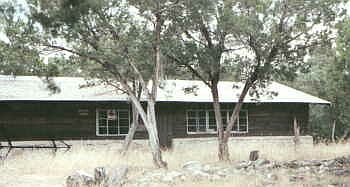 Their plans were
to lay the foundation before the summer of 1959 was
over. By September of 1960 the rock part of the wall,
cement floor and plumbing were completed. They were
now ready to start on the walls and roof. The rock for
the walls was gathered by OA members during their
Ordeals. By April 1962, they still lacked the windows
and fireplace. Raymond Richardson was not an OA
member, but an expert rock mason. He was responsible
for building the walls and the fireplace. Reve Ponder
related that as a little girl she used to go out to
camp with her father Bill Lynn as he worked on the
Lodge. She remembers that the weekend they finished
the fireplace that it started to snow. It was so cold
that they went ahead and built a fire in the fireplace
even though the cement was not totally dry. Their plans were
to lay the foundation before the summer of 1959 was
over. By September of 1960 the rock part of the wall,
cement floor and plumbing were completed. They were
now ready to start on the walls and roof. The rock for
the walls was gathered by OA members during their
Ordeals. By April 1962, they still lacked the windows
and fireplace. Raymond Richardson was not an OA
member, but an expert rock mason. He was responsible
for building the walls and the fireplace. Reve Ponder
related that as a little girl she used to go out to
camp with her father Bill Lynn as he worked on the
Lodge. She remembers that the weekend they finished
the fireplace that it started to snow. It was so cold
that they went ahead and built a fire in the fireplace
even though the cement was not totally dry.
The
building was finally completed and the lodge was
dedicated during summer camp in 1963. When Lois Gee
passed away on October 11, 1977, the building was
named in his memory and is known to this day as "Gee
Lodge." During the 80's a portion of the North
end of the Lodge was petitioned off and converted
into the First Aid Lodge for the camp when the State
Health Department would no longer allow the camp to
use the room at the end of the dining hall for this
purpose. Calling Out Ceremony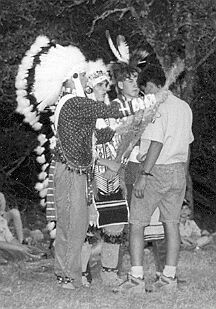 Mrs. J. C. Gibson of Richland Springs wrote
a story about the calling out ceremony held by the
Lodge at Camp Billy Gibbons. Her son, John Gibson, of
Richland Springs Troop 36, was inducted into the Order
of the Arrow in the summer of 1976. He received his
Brotherhood in in 1978 and served on the summer camp
staff. Mrs. J. C. Gibson of Richland Springs wrote
a story about the calling out ceremony held by the
Lodge at Camp Billy Gibbons. Her son, John Gibson, of
Richland Springs Troop 36, was inducted into the Order
of the Arrow in the summer of 1976. He received his
Brotherhood in in 1978 and served on the summer camp
staff.
“The moon is almost full and sheds its soft light. As you cross Plum Hollow you are told to remain silent cross your arms Indian fashion. As you near the Council Ring of the Otena Lodge you hear the chant of young Scout Braves. ‘You are an outsider,’ but you will know by the sincere deep ring of the young male voices that this is important to them, therefore you respect their ceremonies and your privilege as a visitor to sit on the outside circle of their council. "The whispering boughs of the cedar are accompanied by the beat of a slow tom-tom drum and from the east comes the figure of an Indian and he explains that the Order of the Arrow is based on service and brotherhood. Still yet another Indian all in full regalia steps forth and invokes the blessings of the spirits in traditional Indian fashion (using the Four Winds Ceremony). Through all of this the tom-tom holds the cadence of the speakers as they circle the council ring. “Then comes the Indian Scout Dancers. You are told how the Indian used the dance to express his many and varied ways of life. It was a great part of the young braves' life to be able to dance in the Council Ring and these young scouts were no different. They began with the Indian heel dance and the cadence of the tom-tom picked up a faster beat. "Then came stories in pantomime dancing that told of evil spirits and their removal by the medicine man. "Now the fun is over and the time for the chosen ones to be called. All is silent, save the wind whispering through the cedar boughs and the crackle of the council fire. "Suddenly, as if by magic across a deep ravine and high atop a bluff is a flaming arrow. From the council ring this gigantic arrow looks 20 feet long with the flames outlining it making it look even larger. Then a loud voice breaks the stillness and says, 'Many are called, but few are chosen' and the young scouts wait in rigid expectation. "If you are called you are to stand up and remove your shirt. Then you are escorted not too gently by a young Indian brave to where the Chief officially 'taps' you for the Order of the Arrow. "Just one name at a time is comes booming into the silence and the chief is his beautiful headdress taps you and you are escorted out of the council ring into the deep ravine. This means you are on your own and your ordeal begins. "From the moment you stand you have just one year to fulfill the tasks the Lodge brother put before you. "When the call out voice is silent and the sounds of the night are again upon you, you hear the call of the Whip-o-will and your spine tingles because you really know it is the call of one of the Indians to another. Then from the bluff comes the screech of an owl answered again by the plaintiff Whip-o-will. "You leave
as you are politely bid to do, filled with curiosity
as to what the night holds. Somehow you are sure
your son or brother will be a better person if he is
man enough to perform the tasks set forth for him to
fulfill. Photo of modern day Calling Out Ceremony
at Camp
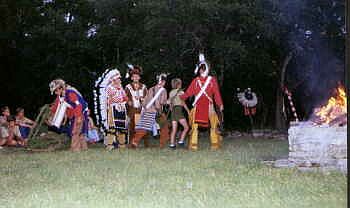 The Order of the
Arrow is something all scouts reach for. It is not
unattainable. It is based on cheerfulness, service,
and brotherhood. The Order of the
Arrow is something all scouts reach for. It is not
unattainable. It is based on cheerfulness, service,
and brotherhood.
"The first ordeal may be passed within one year - the other two may take an entire lifetime. It depends on the candidate for the degree." Mrs. Gibson pretty well describes what the calling out ceremony has been for many years at Camp Billy Gibbons. Only a few changes have been made over the years. The Scouts no longer remove their shirts before having a wreath placed around them and they are treated more gently as they are led around the council ring to the bluff, all brought about by changes in time. But as she said, "Many are called, but few are chosen." In the fifty-eight year history of the lodge over 1,500 Scouts and Scouters in the Comanche Trail Council have been called to membership in the OA. The Four Winds Ceremony has been used to open their campfire since the lodge was formed in 1945 and has been used in the council's summer camps since 1922. We have included this ceremony in Otena's history for all to enjoy. Go HERE for the ceremony.
Ric
Wilkins recalls his memories of the induction
ceremony and his experiences in the lodge in the
1950's. You can read his story by going HERE.
"Lou or
Blacky," "Was it
not at the 1961 area 9D meeting that you wanted a fire
lighting that was similar to what Tracy was doing in
camp? I told one of you that we didn't have the
aircraft nicrome
wire that Tracy used on his fire lighting and that we
had to do something different. "If I
recall correctly (and that may not be) we went to the
Ranger at Camp Billy Gibbons and he gave us a roll of
wire that was normally used for bailing hay and a 12
inch X quarter inch copper tube that would slide over
the wire. We strung that from a tree top (which we
climbed with a ladder) across the river or creek and
it ended up in the campfire set up in a big open area
at Billy Gibbons. We wrapped toilet paper tightly
around the quarter inch X 12 inch copper tube and
soaked it with
diesel. We could light it from up in the tree and it
would slide down the wire to the campfire as you
either Lou or Blacky
raised your hands to the four winds. "It went down about halfway (over the middle of the river or creek) and hung. It stayed there about 15 or 20 seconds and then started sliding the rest of the way down. I was mystified as what had happened and the Ranger said we must have had a small kink in the bailing wire. The wire which after it got hot with the torch hanging on it allowed it to smooth out enough to allow the torch to slide the rest of the way down. He also mentioned we were really lucky that that kink didn't break when it heated up. Is any of this familiar to either of you??" First Brotherhood MembersNewsletterBack to Index Women in the LodgeBoth Reve
Ponder and Betty Hart achieved the Vigil Honor.
Lodge PatchesDuring 1956 the first Lodge patch for wear on the right pocket flap of the Scout uniform was designed and sold to members in the Lodge for thirty-five cents each. The patch was designed by Dabney Kennedy after seeing them at an Area meeting. This first pocket flap had a white background with a black border. Across the top of the patch was a red arrow pointed to the left with the word "Otena" inscribed on through the arrow. Below this was a teepee with "295" in the center. A "W" was located on each side of the teepee with one inside the teepee just above the "295." Feathers formed the bottom border of the flap.
Brotherhood/Vigil PatchLater, both Brotherhood and Vigil patches were designed for the lodge. Here are the last patches used in the lodge for Brotherhood and Vigil members.   Several times they have had a special flap made to take with them to the conference to trade. Here is one of the more recent patches that was taken to the 2002 National Order of the Arrow Conference (NOAC). It was called the Dr. Pepper patch. You can make out the ghost printing on the left and right side of the patch. "NOAC 2002" and "Otena 295"
Anniversary PatchesA new Fiftieth Anniversary patch was designed in 1994 for the "real" anniversary. The Lodge decided to reissue the original 1956 lodge patch but add "1945-1995" to the patch and a white Scout emblem in the background. The patch was made available to anyone who wanted to purchase it. Lodge NeckerchiefsThe second Lodge neckerchief was designed by Jimmy Erwin and made available to the members of Otena in the Spring of 1967. A fully embroidered patch, for $2.25, was designed to be sewn on the back of a white satin neckerchief with fringe. Each member was urged to buy the patch and make their own neckerchief. Later, the neckerchief with patch sewed on was made available by the Lodge. When all the patches were gone, each member made and wore just the neckerchief with fringe. Today that is the official neckerchief of the Lodge. In recognition of the 50th Anniversary of the Lodge, a new neckerchief patch was designed by Michael Beach and Michael Denison and issued in the Fall of 1994. This design featured all the previous emblems of various flaps. It had the teepee, Indian head and Arrowhead plus Ordeal, Brotherhood, and Vigil sashes. In 1996 a new neckerchief patch was designed by Chris Firth with the art work done by Tully Hair. It depicts the Four Winds Ceremony at Camp Billy Gibbons. The patch is fully embroidered with a gold border. Canvas PaintingIt was
used as a backdrop for a lodge banquet and other
lodge events. We will post more information as
find it among our older members who probably
remember the event and the reason it was
painted. We thank Don Walske for saving this
canvas for the lodge and giving it to the Brown
County Museum of History. E. Urner Goodman Camping AwardBack to Index Lodge Chiefs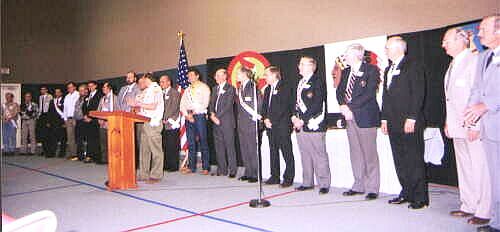 OA 1995 50th Anniversary Banquet Lodge Chiefs, Right to Left: Connie Mack Hood, Eddie Hart, Lloyd Carter, Burts Kennedy, Dabney Kennedy, Bryan Healer, Thomas R. Seely, Jr., Carl B. Sanders, Jerry Jackson, Dr. John "Eddie" Garner, Ernie A. Meyer, Stanley W. Walker, James C. Reed, Joseph B. Swanner, Pat Leatherwood, Ronnie L. Schackelford, Richard A. Crenswaw, Rickey L. Wilson, Jeff Nix, Sam Mangrum, Perry A. Wakefield, Jr. The most important youth leader of a lodge is the Lodge Chief. They are responsible foring seeing that the Lodge runs smoothly and, with a group of officers, carries out the various projects, ceremonies and activities of the lodge during their term of office. Currently, all but two of the Otena Lodge Chiefs are still living, most within Texas. A list of Chiefs with the town they lived in at the time of their election includes: 1945 -
Connie Mack Hood, Breckenridge Lodge Advisers1946 - Guy
T. Smith, Brownwood Supreme Chiefs of the Fire1945-1953
- Guy N. Quirl Section Conclaves1955 -
Area 9-D at Camp Billy Gibbons 50th AnniversaryBack to Index Vigil Honor MembersThis list of names contain the date that the application was submitted to the Order of the Arrow and not by the year they were inducted. For instance, four Arrowmen were submitted to National in March 1990, and another group was submitted in October of the same year. 1955 - Leo
Buckmaster, James M. Cooper, Dabney Kennedy
Founder's AwardThe award was first presented in the Otena Lodge at the 50th Anniversary Banquet on on January 7, 1995 to Michael D. Beach, Stephenville and Perry A. “Butch” Wakefield, Jr., Stephenville. 1996:
Michael H. Denison, Brownwood Dabney Kennedy, former Lodge Chief of the Otena Lodge, received the Order of the Arrow's Legacy of Servant Leadership Award at the National Order of the Arrow Conference held at the University of Michigan in the summer of 2006. For the full story on the award and Kennedy go to: Dabney Kennedy Final Lodge Fall Fellowship
Final Officers of the Lodge - 2003Vice Chief of Dancing - Jon Durand Vice Chief of Activities - Jared Blair Vice Chief of Camping - Chad Iley Secretary - Buck Paolino Treasurer - Chris Harris Lodge Adviser - Sam Mangrum Staff Adviser - Les Zimmerman Back to index Final Otena Lodge Banquet| E-Book On Otena Lodge |
Back to Index |
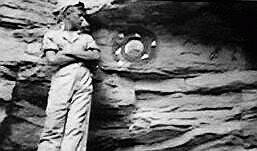 The organization continued to be well
organized up until the time the National Scout
Office replaced this with the Order of the Arrow in
1945. Shown on the left is Eagle Scout Winston
Bowles of Eastland when he was "Fire Lighter" during
a Kunieh ceremony.
The organization continued to be well
organized up until the time the National Scout
Office replaced this with the Order of the Arrow in
1945. Shown on the left is Eagle Scout Winston
Bowles of Eastland when he was "Fire Lighter" during
a Kunieh ceremony. 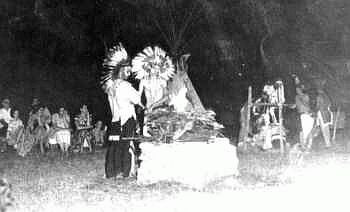 In 1946 the Lodge held its first campfire
to call out new candidates. Some 48 new members were
inducted at the old Camp Billy Gibbons.
The new Lodge played a major role in moving the camp
equipment to the new Camp Billy Gibbons later that
year as its first service project. By the end of
1946, their first full year as a lodge, they had 132
members registered, having inducted 48 new members
during the year. That same year the first two
Brotherhood members were inducted in ceremonies at
another lodge.
In 1946 the Lodge held its first campfire
to call out new candidates. Some 48 new members were
inducted at the old Camp Billy Gibbons.
The new Lodge played a major role in moving the camp
equipment to the new Camp Billy Gibbons later that
year as its first service project. By the end of
1946, their first full year as a lodge, they had 132
members registered, having inducted 48 new members
during the year. That same year the first two
Brotherhood members were inducted in ceremonies at
another lodge. 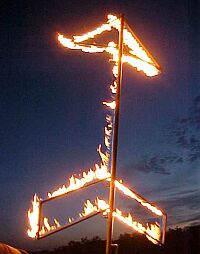 Another tradition that the lodge used in
the Calling Out Ceremony for many years has been a
flaming arrow. The arrow is set on a bluff
overlooking the council ring. At first, the
arrow was wrapped in burlap, soaked with kerosene,
and was lighted at the beginning of the
calling out ceremony itself. However, the arrow
tended to come apart as the burlap burned and did
not last through the evening. The National
Order of the Arrow ended the practice of using
kerosene in camp in early 1993. To replace the
use of kerosene, an engineer Scouting in
Stephenville came up with the idea of using an arrow
with gas holes in the metal pipe, fed by propane,
much like the burners on a stove. The first
arrow of this new invention did not distribute the
gas evenly around the arrow, so a second attempt was
made to improve the flow of the gas. This
arrow proved to be a great improvement over the last
one. It is still in use today and is always
supervised by an adult.
Another tradition that the lodge used in
the Calling Out Ceremony for many years has been a
flaming arrow. The arrow is set on a bluff
overlooking the council ring. At first, the
arrow was wrapped in burlap, soaked with kerosene,
and was lighted at the beginning of the
calling out ceremony itself. However, the arrow
tended to come apart as the burlap burned and did
not last through the evening. The National
Order of the Arrow ended the practice of using
kerosene in camp in early 1993. To replace the
use of kerosene, an engineer Scouting in
Stephenville came up with the idea of using an arrow
with gas holes in the metal pipe, fed by propane,
much like the burners on a stove. The first
arrow of this new invention did not distribute the
gas evenly around the arrow, so a second attempt was
made to improve the flow of the gas. This
arrow proved to be a great improvement over the last
one. It is still in use today and is always
supervised by an adult.  The present Ordeal Patch was designed
around 1968 and had seven colors. It had a black
border and a blue background with twenty feathers
hanging from the bottom of the flap. One could buy
the patch for $1.00. The teepee was kept on the
design from the old patch but moved to the left side
of the patch. A new Indian Head, which would later
be used along with the teepee as the Lodge totem,
was placed on the right side of the patch .
The present Ordeal Patch was designed
around 1968 and had seven colors. It had a black
border and a blue background with twenty feathers
hanging from the bottom of the flap. One could buy
the patch for $1.00. The teepee was kept on the
design from the old patch but moved to the left side
of the patch. A new Indian Head, which would later
be used along with the teepee as the Lodge totem,
was placed on the right side of the patch .

